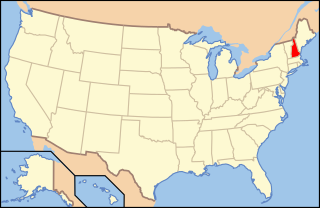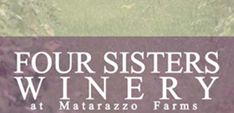Related Research Articles

Jewell Towne Vineyards is a winery in the state of New Hampshire. The property is located on the hills overlooking the Powwow River a few miles from the Atlantic Ocean. The property is the oldest currently producing winery in New Hampshire, and is seen as a leader in establishing northern New England cold hardy cultivars.
Wine has been produced in the United States since the 1500s, with the first widespread production beginning in New Mexico in 1628. Today, wine production is undertaken in all fifty states, with California producing 84 percent of all US wine. The North American continent is home to several native species of grape, including Vitis labrusca, Vitis riparia, Vitis rotundifolia, and Vitis vulpina, but the wine-making industry is based almost entirely on the cultivation of the European Vitis vinifera, which was introduced by European settlers. With more than 1,100,000 acres (4,500 km2) under vine, the United States is the fourth-largest wine producing country in the world, after Italy, Spain, and France.

Washington wine is a wine produced from grape varieties grown in the U.S. state of Washington. Washington ranks second in the United States in the production of wine. By 2017, the state had over 55,000 acres (220 km2) of vineyards, a harvest of 229,000 short tons (208,000 t) of grapes, and exports going to over 40 countries around the world from the 940+ wineries located in the state. While there are some viticultural activities in the cooler, wetter western half of the state, the majority (99.9%) of wine grape production takes place in the shrub-steppe eastern half. The rain shadow of the Cascade Range leaves the Columbia River Basin with around 8 inches (200 mm) of annual rain fall, making irrigation and water rights of paramount interest to the Washington wine industry. Viticulture in the state is also influenced by long sunlight hours and consistent temperatures.

The production of wine in New Jersey has increased significantly in the last thirty years with the opening of new wineries. Beginning in 1981, the state legislature relaxed Prohibition-era restrictions and crafted new laws to facilitate the growth of the industry and provide new opportunities for winery licenses. Today, New Jersey wineries are crafting wines that have earned recognition for their quality from critics, industry leaders, and in national and international competitions. As of 2019, New Jersey currently has 51 licensed and operating wineries with several more prospective wineries in various stages of development.

New Mexico has a long history of wine production, within American wine, especially along the Rio Grande, from its capital Santa Fe, the city of Albuquerque with its surrounding metropolitan area, and in valleys like the Mesilla and the Mimbres River valleys. In 1629, Franciscan friar García de Zúñiga and a Capuchín monk named Antonio de Arteaga planted the first wine grapes in Santa Fe de Nuevo México, in what would become the modern Middle Rio Grande Valley AVA. Today, wineries exist in the aforementioned Middle Rio Grande Valley, as well as the Mesilla Valley AVA and the Mimbres Valley AVA.

Iowa wine refers to wine manufactured in the U.S. state of Iowa. Iowa presents many challenges to viticulture including very warm summer days that can promote fungal vine diseases, and extremely cold winter nights that can kill many varieties of grapevines. Most commercial viticulture in Iowa focuses on French hybrid and native American grape varieties, with relatively few plantings of Vitis vinifera grapes. Many Iowa wineries also import grapes and juice from other states and countries in order to produce wine varietals otherwise not possible due to Iowa's harsh winter months that will not permit such grapes to survive. Iowa is home to 100 commercial wineries and more than 300 vineyards covering 1,200+ acres. Northeastern Iowa is included in the Upper Mississippi Valley AVA while the western part of the state is in the new AVA designation named Loess Hills.

New Hampshire wine refers to wine made from grapes grown in the U.S. state of New Hampshire. The wine industry in New Hampshire began in 1994 when two wineries, Jewell Towne Vineyards and Flag Hill Winery, each produced their first vintages from locally grown grapes. Candia Vineyards started their test plantings in 1992, and full planting in 1998. New Hampshire continues to be growing wine-producing state, with new commercial wineries opening. The state currently has no American Viticultural Areas.

The El Dorado AVA is an American Viticultural Area located in El Dorado County, California, United States. Wine grape growers in the region produce a large diversity of varietals, notable varietals are Zinfandel, Barbera, Cabernet Sauvignon, Merlot and Petite Sirah and there are significant plantings of Rhône varietals. Located in the foothills of the Sierra Nevada mountains, vineyards are found primarily at elevations between 600 feet (183 m) and 3,500 feet (1,067 m) above sea level and some of the historic and revered vineyards are planted above 2,000 feet (610 m) elevation. The region benefits from the cool breezes that come off the mountains and push hot air off the vines and down to the valley. The soils of the region are magma based with high levels of acidity.

Inniskillin is a Canadian winery located in Niagara-on-the-Lake, Ontario. Inniskillin, which is mainly noted for its icewine production, has played an important pioneering role in the modern Canadian wine industry. Since 1994, Inniskillin also operates a winery in Okanagan, British Columbia in addition to its original location.

The Upper Mississippi River Valley AVA is an American Viticultural Area covering 29,914 square miles located along the Upper Mississippi River and its tributaries in northwest Illinois, northeast Iowa, southeast Minnesota and southwest Wisconsin. Certified by the United States Department of the Treasury's Alcohol and Tobacco Tax and Trade Bureau on July 22, 2009, it is the largest AVA in the United States. The AVA encompasses an area 50 times larger than the Bordeaux wine regions of France.
Nassau Valley Vineyards was the first winery in the state of Delaware in the United States, and is currently the largest in the state. When jazz singer Peggy Raley decided to open a winery in Delaware, she first had to get the local state legislature to pass a law allowing wineries in the state. By 1991 she drafted the necessary legislation, and she obtained a license and opened the vineyard in 1993. Until October 2007, when Pizzadili Winery opened, it was the first and only winery in the state. There are eight acres of property at the site, and it caters to the beach-bound tourist traffic in the area.
Alba Vineyard is an American winery in the Finesville section of Pohatcong Township in Warren County, New Jersey. Formerly a dairy farm, the vineyard was first planted in 1980, and opened to the public in 1982. Alba is one of the larger winegrowers in New Jersey, having 42 acres of grapes under cultivation, and producing 11,000 cases of wine per year. The winery is named for the Italian word alba which means "dawn," the time of day when the original owner first conceived of producing wine.

Westfall Winery was a winery in Montague Township in Sussex County, New Jersey. Formerly a stop on the Underground Railroad and a dairy farm, the vineyard was first planted in 2000, and opened to the public in 2003. Westfall had 6 acres of grapes under cultivation, and produced 9,000 cases of wine per year, mostly from imported grapes. The winery was named for the family that owned the farm from 1774 to 1940. It was sold in December 2017 and became an animal sanctuary.

Beneduce Vineyards is a winery in the Pittstown section of Alexandria Township in Hunterdon County, New Jersey, United States. A family farm since 2000, the vineyard was first planted in 2009, and opened to the public in 2012. Beneduce has 10 acres of grapes under cultivation, and produces 4,000 cases of wine per year. The winery is named after the family that owns it.

Brook Hollow Winery is a winery in the Columbia section of Knowlton Township in Warren County, New Jersey. Brook Hollow's original vineyard was first planted in 2002, and opened to the public in 2007. In 2013, the winery moved to a new location in Columbia. Brook Hollow has 8 acres of grapes under cultivation, and produces 1,050 cases of wine per year. The winery is named for a hollow created by Yards Creek, a stream that runs through the farm's original location.

Hawk Haven Vineyard & Winery is a winery in Rio Grande section of Lower Township in Cape May County, New Jersey. A family dairy and produce farm since 1940, the vineyard was first planted in 1997, beginning with Cabernet Sauvignon. The winery opened their doors to the public in 2009 with their first vintage in 2007, which consisted of the American Kestrel White, Red Table Wine, Merlot, and Cabernet Sauvignon. Today, Hawk Haven has 16 acres of grapes under cultivation, and produces 5,000 cases of wine per year. The winery is named for the large number of hawks that migrate to the farm every year. They currently have sixteen different varietals and all of the grapes are harvested, pressed, fermented, aged, blended, and bottled on site.

Four Sisters Winery at Matarazzo Farm is a winery in White Township in Warren County, New Jersey. A family produce farm since 1921, the vineyard was first planted in 1981, and opened to the public in 1984. It is the third oldest winery in New Jersey. Four Sisters has 8 acres of grapes under cultivation, and produces 5,000 cases of wine per year. The winery is so named because its owners have four daughters.

Ventimiglia Vineyard is a winery in Wantage Township in Sussex County, New Jersey. The vineyard was first planted in 2002, and opened to the public in 2008. Ventimiglia has 5 acres of grapes under cultivation, and produces 1,000 cases of wine per year. The winery is named after the family that owns it.
Landot noir is a red hybrid grape variety that is a crossing of Landal and Villard blanc. Created after a series of trials between 1929-1949, the grape was introduced to Canada and the United States in the 1950s and today can be found in Quebec as well as New Hampshire where a varietal is produced by Jewell Towne Vineyards.
References
- ↑ Kevin Zraly, Kevin Zraly's American Wine Guide, p.123 (2007)
- ↑ DeVito, Carlo (November 30, 2021). The Spirit of Rye: Over 300 Expressions to Celebrate the Rye Revival. Simon and Schuster. p. 128. ISBN 978-1-64643-178-6.
- 1 2 Carlo DeVito, East Coast wineries: a complete guide from Maine to Virginia p.45-46 (2003) ( ISBN 978-0813533124)
- 1 2 3 Cattell, Hudson. Wine East. appellationamerica.com (Jan-Feb 2004). The Wineries of New Hampshire
- ↑ Cattell, Hudson (January 15, 2014). Wines of Eastern North America: From Prohibition to the Present—A History and Desk Reference. Cornell University Press. ISBN 978-0-8014-6899-5.
- 1 2 Cattell, Hudson, Wines & Vines (December 8, 2008). "New Hampshire Producers Stand Together".
- ↑ "Carving a niche in new England's North country". Wines & Vines. January 2006. Retrieved January 20, 2010.